| Final Statistics: Alex & Maz | Total distance: 93,550km |
| Furthest Point: Rotorua, NZ | Now settled in Sydney, Australia |
| Final Statistics: Martin | Total distance: 79,698km |
| Furthest Point: Hobart, Australia | Now settled in Bristol, UK |
New Zealand
|
| Arrive: | Sat 16th Dec 06 | Depart: | Sat 10th Feb 07 |
| Days: | 56 | Approx km: | 3700 |
| Capital: | Wellington | Currency: | Dollar (NZD) |
| Weekend: | Sat/Sun | Time Zone: | GMT +12 |
| Int. dial code: | +64 | Language: | English, Maori |
| Visa Required: | No | Religion: | Anglican, Presbyterian, Roman Catholic |
| Side of road: | Left | Best time to visit: | Nov-Apr |
| Diesel Price: | US$ 0.41 | Activities: | Sightseeing, Diving, Trekking, Rafting |
Click here to see our mission statement in English.
Diary Entry: 23rd - 29th March 2007 - Sweet as, Bro!
Diary Entry: 30th March - 3rd April 2007 - Best foot forward...
Diary Entry: 4th April - 8th April 2007 - Adrenaline Fix NZ
Diary Entry: 10th April 2007 - Can it really be over..?
Photo Album for New Zealand
Country Highlights En Route
Volcanoes
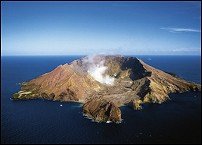 The active volcanoes of New Zealand are all part of the Taupo Volcanic Zone, a strip of land that extends NE from the centre of the North Island into the Bay of Plenty. There the earth's crust is stretched and down faulted, as a result of the sinking of the Pacific tectonic plate underneath the Australian tectonic plate, several tens of kilometres below the surface of the North Island. The most continuously active is White Island in the Bay of Plenty. Tongariro has several geothermal areas, while Ngaruhoe and Ruapehu erupt intermittently, every few years or decades. On each of these volcanoes there are good opportunities to discover an active volcanic landscape and to observe volcanic activity at work.
The active volcanoes of New Zealand are all part of the Taupo Volcanic Zone, a strip of land that extends NE from the centre of the North Island into the Bay of Plenty. There the earth's crust is stretched and down faulted, as a result of the sinking of the Pacific tectonic plate underneath the Australian tectonic plate, several tens of kilometres below the surface of the North Island. The most continuously active is White Island in the Bay of Plenty. Tongariro has several geothermal areas, while Ngaruhoe and Ruapehu erupt intermittently, every few years or decades. On each of these volcanoes there are good opportunities to discover an active volcanic landscape and to observe volcanic activity at work.
Glaciers
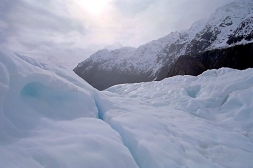 At a latitude of only forty-four degrees south and in a relatively mild climate, no other glaciers in the world are as easily accessible as Fox and Franz Josef.
At a latitude of only forty-four degrees south and in a relatively mild climate, no other glaciers in the world are as easily accessible as Fox and Franz Josef.
Fed by four alpine glaciers, Fox Glacier falls 2600 metres on its 13 kilometre journey towards the coast. Named after an early New Zealand Prime Minister, William Fox, the glacier is 300 metres deep and its terminal face is just 5 kilometres from the township. The road to the glacier crosses ancient moraine from earlier advances and retreats.
Approximately 7000 years old, and a remnant of a much older and larger glacier which originally swept right to the sea, Franz Josef Glacier extends 12 kilometres from its three feeder glaciers in the high snow fields of the Alps. Today the terminal face is a mere 19 kilometres from the sea and just 5 kilometres from the township.
White water rafting
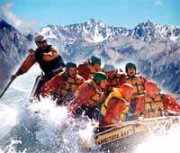 White water rafting is a major adrenaline rush. At the mercy of a pounding torrent you just have to let yourself go! It provides excitement by descending challenging rapids but allows you to gain your breath back by including stretches of quiet water allowing ample time to practice paddling & rafting techniques. It's also a good way to see breathtaking scenery.
White water rafting is a major adrenaline rush. At the mercy of a pounding torrent you just have to let yourself go! It provides excitement by descending challenging rapids but allows you to gain your breath back by including stretches of quiet water allowing ample time to practice paddling & rafting techniques. It's also a good way to see breathtaking scenery.
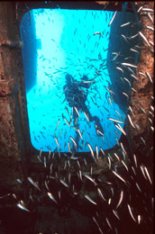 Diving: There is an abundance of different sceneries to satisfy every diver. From coral to ship wrecks to sharks. Black coral is usually found in depths greater than 45 metres, but has been found in abundance in the waters of Fiordland from a depth of 5 metres.
Diving: There is an abundance of different sceneries to satisfy every diver. From coral to ship wrecks to sharks. Black coral is usually found in depths greater than 45 metres, but has been found in abundance in the waters of Fiordland from a depth of 5 metres.
Wreck diving off the Bay of Islands - HMNZS Tui, at 62 metres long she now lies in 30 metres of water just 2km north of Tutukaka Heads.. HMNZS Waikato sunk in November 2000 and now lies 30 metres down and bolt upright on the seabed.
There are a number of places where shark cage diving can be done in New Zealand. The two most common shark species in New Zealand are mako and blue sharks.
Tongariro National Park
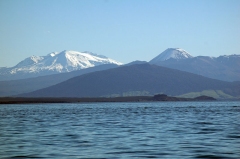 The mountains at the heart of the park have cultural and religious significance for the Maori people and symbolize the spiritual links between this community and its environment. The park has active and extinct volcanoes, a diverse range of ecosystems and some spectacular landscapes. Volcanic activity in the zone started about 2 million years ago and is on-going today. Ruapehu and Ngauruhoe are two of the most active composite volcanoes in the world. In 1995 and again in 1996 Ruapehu has erupted in spectacular fashion sending clouds of ash and steam skyward and mantling the surrounding snow fields and forest with a thick film of ash.
The mountains at the heart of the park have cultural and religious significance for the Maori people and symbolize the spiritual links between this community and its environment. The park has active and extinct volcanoes, a diverse range of ecosystems and some spectacular landscapes. Volcanic activity in the zone started about 2 million years ago and is on-going today. Ruapehu and Ngauruhoe are two of the most active composite volcanoes in the world. In 1995 and again in 1996 Ruapehu has erupted in spectacular fashion sending clouds of ash and steam skyward and mantling the surrounding snow fields and forest with a thick film of ash.
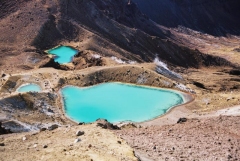 It is a land of strong contrasts. Chaotic, barren lava flows, winter snowfields, hot springs and active craters can be seen side by side. It is a harsh environment for plants; poor pumice soils and volcanic activity slows the development of diverse forests yet some pockets
It is a land of strong contrasts. Chaotic, barren lava flows, winter snowfields, hot springs and active craters can be seen side by side. It is a harsh environment for plants; poor pumice soils and volcanic activity slows the development of diverse forests yet some pockets 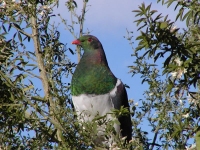 of magnificent podocarp forest can be found.
of magnificent podocarp forest can be found.
Tongariro is home to many amazing native creatures including New Zealand's only native mammals, the short and long tailed bats. Birds you might see during daylight include North Island robins, fantails, parakeets and even a kereru (native pigeon) or two. Smaller, but no less interesting are the numerous insects that live in the park.
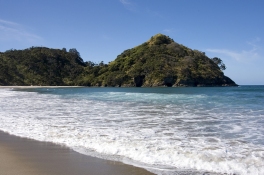 Great Barrier Island: This island at the mouth of the Hauraki Gulf has acres of long, white sandy beaches on its eastern shore, deep-water sheltered inlets on its western shore,
Great Barrier Island: This island at the mouth of the Hauraki Gulf has acres of long, white sandy beaches on its eastern shore, deep-water sheltered inlets on its western shore, 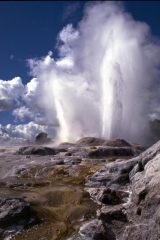 and a rugged spine of steep ridges running down the centre. The 80,000ha (197,684ac) reserve has a number of walking tracks that combine old logging trails and tramways. Natural hot springs, towering kauri forests and a serene aura make it a perfect escape.
and a rugged spine of steep ridges running down the centre. The 80,000ha (197,684ac) reserve has a number of walking tracks that combine old logging trails and tramways. Natural hot springs, towering kauri forests and a serene aura make it a perfect escape.
Rotorua
North Island's geographic and geothermal center lies in Rotorua, where pools of mud bubble from the ground. Here only 4km of soil and rock separates the earth's crust from the magma layer.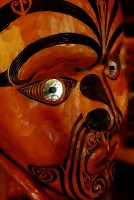
Indigenous Culture
The Māori people are the indigenous people of Aotearoa (New Zealand) and first arrived here in waka hourua (voyaging canoes) from their ancestral homeland of Hawaiki over 1000 years ago. Today, Māori make up over 14 percent of the population. Their language and culture has a major impact on all facets of New Zealand life. Māori culture is a rich and varied one, and includes traditional and contemporary arts. Traditional arts such as carving, weaving, kapa haka (group performance), whaikorero (oratory) and moko (tattoo) are practised throughout the country. Practitioners following in the footsteps of their tipuna (ancestors) replicate the techniques used hundreds of years ago, yet also develop exciting new techniques and forms.
| All content copyright � overland-underwater.com - please do not use without permission. |
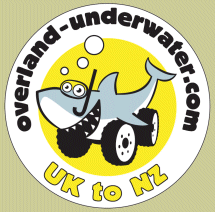

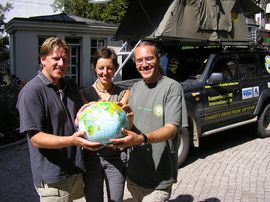
 New Zealand
New Zealand 

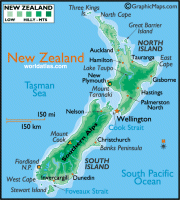
 Previous: Australia
Previous: Australia
